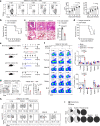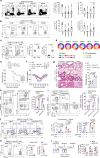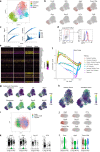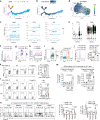Host-derived lipids orchestrate pulmonary γδ T cell response to provide early protection against influenza virus infection
- PMID: 33772013
- PMCID: PMC7997921
- DOI: 10.1038/s41467-021-22242-9
Host-derived lipids orchestrate pulmonary γδ T cell response to provide early protection against influenza virus infection
Abstract
Innate immunity is important for host defense by eliciting rapid anti-viral responses and bridging adaptive immunity. Here, we show that endogenous lipids released from virus-infected host cells activate lung γδ T cells to produce interleukin 17 A (IL-17A) for early protection against H1N1 influenza infection. During infection, the lung γδ T cell pool is constantly supplemented by thymic output, with recent emigrants infiltrating into the lung parenchyma and airway to acquire tissue-resident feature. Single-cell studies identify IL-17A-producing γδ T (Tγδ17) cells with a phenotype of TCRγδhiCD3hiAQP3hiCXCR6hi in both infected mice and patients with pneumonia. Mechanistically, host cell-released lipids during viral infection are presented by lung infiltrating CD1d+ B-1a cells to activate IL-17A production in γδ T cells via γδTCR-mediated IRF4-dependent transcription. Reduced IL-17A production in γδ T cells is detected in mice either lacking B-1a cells or with ablated CD1d in B cells. Our findings identify a local host-immune crosstalk and define important cellular and molecular mediators for early innate defense against lung viral infection.
Conflict of interest statement
The authors declare no competing interests.
Figures







Similar articles
-
Lung γδ T Cells Mediate Protective Responses during Neonatal Influenza Infection that Are Associated with Type 2 Immunity.Immunity. 2018 Sep 18;49(3):531-544.e6. doi: 10.1016/j.immuni.2018.07.011. Epub 2018 Aug 28. Immunity. 2018. PMID: 30170813 Free PMC article.
-
Protective role of γδ T cells in cigarette smoke and influenza infection.Mucosal Immunol. 2018 May;11(3):894-908. doi: 10.1038/mi.2017.93. Epub 2017 Nov 1. Mucosal Immunol. 2018. PMID: 29091081 Free PMC article.
-
Early production of IL-17A by γδ T cells in the trachea promotes viral clearance during influenza infection in mice.Eur J Immunol. 2020 Jan;50(1):97-109. doi: 10.1002/eji.201948157. Epub 2019 Dec 4. Eur J Immunol. 2020. PMID: 31777067 Free PMC article.
-
Role of γδ T cells in controlling viral infections with a focus on influenza virus: implications for designing novel therapeutic approaches.Virol J. 2020 Nov 12;17(1):174. doi: 10.1186/s12985-020-01449-0. Virol J. 2020. PMID: 33183352 Free PMC article. Review.
-
Regulation and function of IL-17A- and IL-22-producing γδ T cells.Cell Mol Life Sci. 2011 Jul;68(14):2371-90. doi: 10.1007/s00018-011-0700-z. Epub 2011 May 15. Cell Mol Life Sci. 2011. PMID: 21573786 Free PMC article. Review.
Cited by
-
Pregnancy enhances antiviral immunity independent of type I IFN but dependent on IL-17-producing γδ+ T cells in the nasal mucosa.Sci Adv. 2024 Sep 27;10(39):eado7087. doi: 10.1126/sciadv.ado7087. Epub 2024 Sep 27. Sci Adv. 2024. PMID: 39331716 Free PMC article.
-
γδ T cells: origin and fate, subsets, diseases and immunotherapy.Signal Transduct Target Ther. 2023 Nov 22;8(1):434. doi: 10.1038/s41392-023-01653-8. Signal Transduct Target Ther. 2023. PMID: 37989744 Free PMC article. Review.
-
Phospholipid metabolites of the gut microbiota promote hypoxia-induced intestinal injury via CD1d-dependent γδ T cells.Gut Microbes. 2022 Jan-Dec;14(1):2096994. doi: 10.1080/19490976.2022.2096994. Gut Microbes. 2022. PMID: 35898110 Free PMC article.
-
Roles of IL-25 in Type 2 Inflammation and Autoimmune Pathogenesis.Front Immunol. 2021 May 28;12:691559. doi: 10.3389/fimmu.2021.691559. eCollection 2021. Front Immunol. 2021. PMID: 34122457 Free PMC article. Review.
-
Interaction of the endogenous antibody response with activating FcγRs enhance control of Mayaro virus through monocytes.PLoS Pathog. 2025 Feb 24;21(2):e1012944. doi: 10.1371/journal.ppat.1012944. eCollection 2025 Feb. PLoS Pathog. 2025. PMID: 39993025 Free PMC article.
References
Publication types
MeSH terms
Substances
LinkOut - more resources
Full Text Sources
Other Literature Sources
Medical
Molecular Biology Databases

